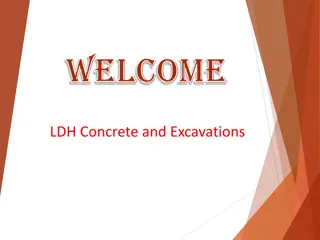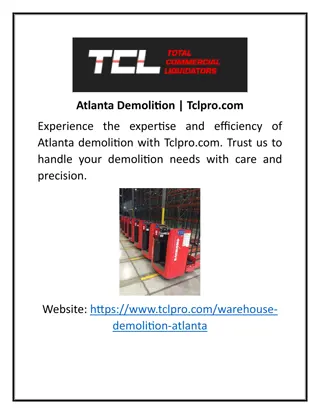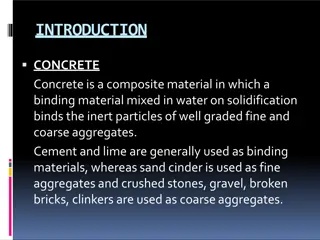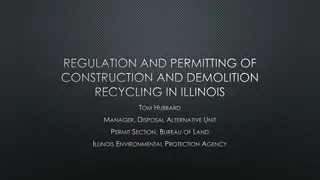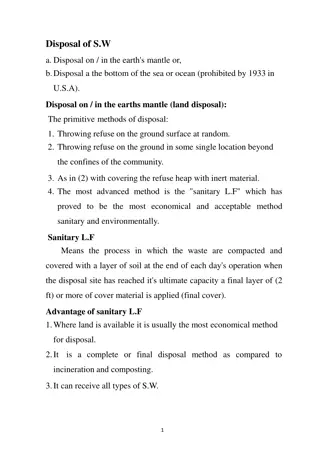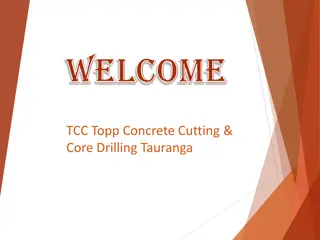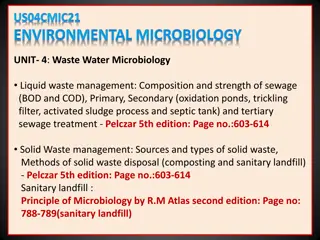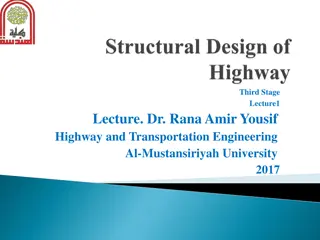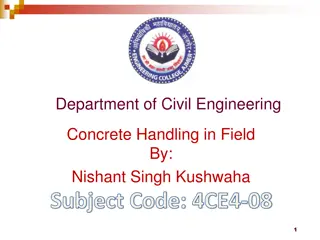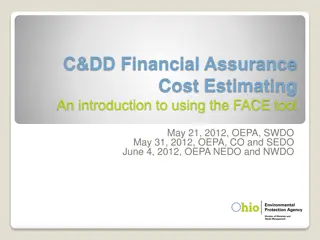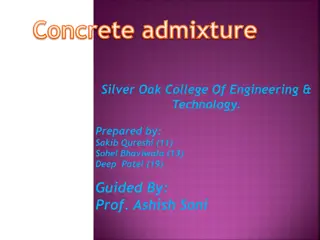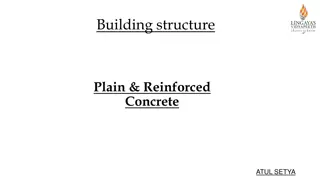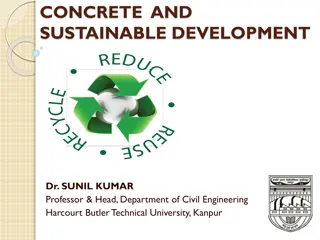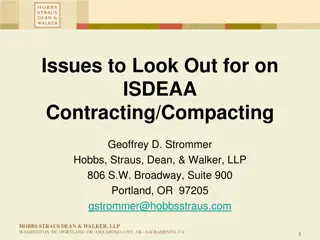Development of Self-Compacting Concrete with Construction and Demolition Waste
This research proposal focuses on developing self-compacting concrete (SCC) using construction and demolition waste. The proposal explores the properties and advantages of SCC, reviews literature on using recycled materials in concrete production, and presents laboratory studies on mechanical properties of SCC incorporating marble waste and polypropylene fiber. The performance of concrete materials containing recycled aggregate from construction and demolition waste is also investigated to evaluate its impact on strength and sustainability.
Download Presentation

Please find below an Image/Link to download the presentation.
The content on the website is provided AS IS for your information and personal use only. It may not be sold, licensed, or shared on other websites without obtaining consent from the author.If you encounter any issues during the download, it is possible that the publisher has removed the file from their server.
You are allowed to download the files provided on this website for personal or commercial use, subject to the condition that they are used lawfully. All files are the property of their respective owners.
The content on the website is provided AS IS for your information and personal use only. It may not be sold, licensed, or shared on other websites without obtaining consent from the author.
E N D
Presentation Transcript
1 Research Proposal on DEVELOPMENT OF SELF COMPACTING CONCRETE USING CONSTRUCTION AND DEMOLITION WASTE PREPARED BY: Ms. Subhrata Biswal Submitted to July 2023
2 Introduction Literature Review Research Gap & Objective/s OUTLINE Methodology Critical Observation Selected References
3 INTRODUCTION
4 Introduction Self-compacting concrete (SCC) can be defined as fresh concrete that flows under its own weight and does not require external vibration to undergo compaction. It is used in construction where it is hard to use vibrators for the consolidation of concrete. Filling and passing ability and segregation resistance are the properties of self-compacting concrete. SCC possesses superior flow ability in its fresh state that performs self-compaction and material consolidation without segregation issues.
5 LITERATURE REVIEW
6 PROPERTIES OF SELF COMPACTING CONCRETE USING RECYCLED COARSE AGGREGATE [1] K C Panda and P K Bal had studied that To comparethe results of SCC with those of normal vibrated concrete (NVC) containing 100% natural coarse aggregate (NCA). The physical and mechanical properties of natural and recycled aggregates in determining their suitability for various applications. NCA is partially replaced with RCA by an amount of 10%, 20%, 30% and 40%, and the effect of RCA on the properties of SCC in the green state and properties of concrete in the hardened state are studied. The mix design was carried out for M25 grade of concrete. The experimental results indicate that SCC with natural aggregate has lower compressive, flexural, and split tensile strength. The present study recommends SCC marginally achieves the required compressive strength up to 30% replacement of RCA
7 LABORATORY STUDY ON MECHANICAL PROPERTIES OF SELF COMPACTING CONCRETE USING MARBLE WASTE AND POLYPROPYLENE FIBER [2] M. Arun Kumar, S. Balaji, S. Selvapraveen, P. Kulanthaivel had studied that The increased waste production in the marble sector and investigation of self-compacting concrete with marble waste and polypropylene fiber. As a result, concrete is created using waste marble and three replacements of 20%, 30%, and 40% in natural fine aggregate. SCC enhances flexural and tensile strength with 0.4% polypropylene fiber, and marble waste of up to 40 % replaces fine aggregate for satisfactory results.
8 PERFORMANCE OF CONCRETE MATERIALS CONTAINING RECYCLED AGGREGATE FROM CONSTRUCTION AND DEMOLITION WASTE [3] Yonatan (Shanko) Ayele Abera had studied that, Recycled aggregate material performance in construction and demolition waste, evaluating its impact on concrete strength and overall benefits. Evaluates recycled aggregate performance in concrete materials as a substitute for conventional aggregate at different rates. Laboratory tests examined recycled aggregate behavior in concrete, to determine performance compared to natural aggregate. 100% recycled aggregate replacement rate analyzed for natural aggregate effects.
9 RECYCLING PRESTRESSED CONCRETE PILE WASTE TO PRODUCE GREEN SELF- COMPACTING CONCRETE [4] Gritsada Sua-iam, Natt Makul had studied that, This article aims to provide prestressed concrete pile waste and FA was used as natural coarse aggregate and cement substitutes in SCC that were studied in the lab for their workability, and hardened characteristics. L-box, U-box, and V-funnel tests were used to investigate the workability of SCC mixes that included RCA as a replacement for coarse natural aggregate FA as a replacement for OPC. Increasing the amount of RCA reduced workability; however, the workability of each SCC mix remained within the standard's acceptable range. Increased viscosity and decreased flowability were characteristics of the SCC fresh mix with more than 75% weight 0f RCA and 50% weight of FA.
10 RESEARCH GAP & OBJECTIVE/S
11 Research Gap After a review of research papers following points were observed: Many researchers had done research in self-compacting concrete with the use of construction and demolition waste. SCC prepared with marble powder. Research Gap: Normal Concrete+ Construction Demolition waste + Marble powder. Self Compacting Concrete + Concrete Demolition waste + Marble powder.
12 Objective/Scope of Work Primary test will be performed for finding out the Physical, properties of all concrete ingredients. Physical properties of construction and demolition waste fine aggregate will be performed. SCC will be prepared by replacing 10 %,20%, and 30% of natural aggregates with construction and demolition waste fine aggregate and Three different samples for C&D waste fine aggregate content would be prepared. Mix design will be prepared for all the samples M20 and M25 grades of the concrete. Test for the Self-compacted concrete will be carried out for all samples. (V funnel, L Box, U Box, Flow slump test)
13 METHODOLOGY
14 COLLECTION OF MATERIALS Fine Aggregate Coarse Aggregates Construction and Demolition Waste FINDING MATERIAL PROPERTIES PREPARING CONCRETE & CASTING THE CUBES By Performing various test Mixing of materials in the machine & the casting the cubes size of 150 150 150 mm CURING Curing them until the test performed TEST PERFORMING ON CUBES Testing strength of cubes by CTM Machine
15 CRITICAL OBSERVCATIONS
CRITICAL OBSERVATIONS Based on the investigation carried out on the Self-compacting concrete with construction demolition waste, the following conclusions were drawn, SCC is a more eco-friendly concrete compared to other concrete technologies due to its ability to eliminate both energy consumption and pollution of the environment. Strength of self-compacting concrete as compared to normal concrete is more. Strength of self-compacting concrete with C&D waste as compared to normal concrete with C&D is more. Overall, 65% of strength is obtained after 7 days, 80% after 14 days and almost 95- 99% strength is obtained after 28 days. Overall, it can be seen from the work that SCC with C&D used in different proportions to get strength as per the research paper, it gain 99% strength after 28 days.
17 SELECTED REFERENCES
18 1. K C Panda , P K Bal (2013). Properties of self-compacting concrete using recycled coarse aggregate,Procedia Engineering 51 ( 2013 ) 159 164 . 2. M. Arun Kumar,S. Balaji, S. Selvapraveen, P. Kulanthaivel . Laboratory study on mechanical properties of self-compacting concrete using marble waste and polypropylene fiber, Cleaner Materials (2022). 3. Yonatan (Shanko) Ayele Abera , Performance of concrete materials containing recycled aggregate from construction and demolition waste, Results in Materials (June-2022). 4. Gritsada Sua-iam, Natt Makul, Recycling prestressed concrete pile waste to produce green self-compacting concrete,Journal of Materials Research and Technology 2023:24, 4587-4600 . 5. Mohammed Abed, Rita Nemes, Bassam A. Tayeh , Properties of self-compacting high- strength concrete containing multiple use of recycled aggregate, Engineering Sciences,108-114-(2020) .
19 THANK YOU THANK YOU





